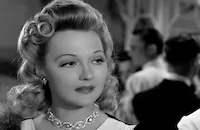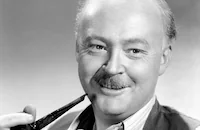The Lone Wolf Strikes

Brief Synopsis
Cast & Crew
Sidney Salkow
Warren William
Joan Perry
Eric Blore
Alan Baxter
Astrid Allwyn
Film Details
Technical Specs

Synopsis
Michael Lanyard, the retired gentleman crook known as the Lone Wolf, is puttering with his aquarium when his old friend, Stanley Young, appears to enlist his aid in recovering a priceless pearl necklace that has been stolen from his murdered friend, Phillip Jordan. Young tells Lanyard that Jordan had found out that Binnie Weldon and her accomplice, Jim Ryder, stole the pearls and replaced them with fakes, and Lanyard agrees to switch the pearls back again. He is hampered in his task, however, by the misguided meddling of Delia Jordan, the murdered man's daughter. Posing as foreign fence Emil Gorlick, Lanyard obtains the pearls from Binnie and Ryder, but after he turns them over to Stanley, his old friend is found murdered and the pearls are discovered missing. Stanley's murder throws suspicion on Lanyard, and to clear himself of the crime, he must find both the murderers and the necklace. To accomplish this, Lanyard tricks the killers into believing that they have the fake pearls and Delia has the real ones. Much to Delia's dismay, Lanyard's trap nets her, suitor Ralph Bolton, and Alberts, the man who hired Bolton to keep an eye on the pearls. After convincing Alberts that he has the genuine pearls, Lanyard leads the killers on a merry chase, which ends on a New York ferryboat where the police await them.

Director
Sidney Salkow
Cast

Warren William

Joan Perry

Eric Blore

Alan Baxter

Astrid Allwyn

Montagu Love
Robert W. Wilcox

Don Beddoe
Fred A. Kelsey

Addison Richards

Roy Gordon
Harland Tucker
Peter Lynn
Maurice Cass
Murray Alper
Robert E. O'connor
Robert Noble
Julius Tannen
Richard Fiske
Joe Mcguinn
Gene Morgan
Harry Bailey
Vernon Dent
Eddie Cobb
Guy Kingsford
Cyril Thornton
Bill Lally
Jack Gardner
Frank Bruno
Ralph Peters
Charles Sherlock

Robert Walker
Crew

Film Details
Technical Specs

Articles
The Lone Wolf Strikes
Vance had introduced the Lone Wolf, Michael Lanyard, as a criminal with a heart of gold in his 1914 novel The Lone Wolf. The character jumped to the silver screen in 1917, with Bert Lytell playing the role. By the time talking films came around, Vance had written four more novels (there would be eight in all). The character's cinematic adventures would resume in 1930 with Henry B. Walthall starring in False Faces. He would be followed by Lytell, Melvyn Douglas and Frances Lederer, all for one film each, before William made the role his own.
Stage veteran William had come to Hollywood with the arrival of talking films and quickly captured a berth at Warner Bros., where he specialized in hypocritical, often villainous businessmen and society mavens. His patrician profile and stage diction made him an ideal villain for early Depression audiences. But when Franklin Roosevelt swept into office in 1932, the type quickly became outdated. Series films (Williams played dapper sleuth Philo Vance twice and defense attorney Perry Mason four times) offered his salvation, albeit in less prestigious productions. He took over the Lone Wolf series at Columbia in 1939 with The Lone Wolf Spy Hunt, and stayed with the character for six films, twice as long as the role's next most prolific interpreter.
For his second outing in the role, The Lone Wolf Strikes, the studio upped the comedy relief by casting veteran character actor Eric Blore as William's valet, Jamieson. Blore had established a reputation as a scene stealer by offering comic highlights in some of the best Fred Astaire-Ginger Rogers musicals, including Top Hat (1935) and Shall We Dance (1937), usually playing eccentric British servants. He would continue with the Lone Wolf series through the rest of William's reign while also appearing in such A-films as Preston Sturges' The Lady Eve and Sullivan's Travels (both 1941).
Director Sidney Salkow would also stick with the series for several films, co-writing two of them. A Hollywood veteran with credits in almost every genre, he would finish his career with low-budget films, most notably the Vincent Price vehicles Twice-Told Tales (1963) and The Last Man on Earth (1964), and television work. Journeyman writer Dalton Trumbo, who wrote the story, would not stay with the series. Instead, he scored a major hit the same year with Kitty Foyle (1940), the film that brought Ginger Rogers an Oscar® and gave Trumbo his first Oscar® nomination. It also marked his move into the ranks of Hollywood's top writers, a position he would hold until his refusal to testify before the House Un-American Activities Committee would lead to his blacklisting and a prison term as a member of the Hollywood Ten.
One of the most interesting careers associated with The Lone Wolf Strikes was leading lady Joan Perry's. As the energetic heiress whose personal investigation of the jewelry theft keeps getting in William's way, she was finishing up her contract with Columbia, but the film hardly marked the end of her association with the studio. After a few more films under a new contract at Warner Bros., she finally accepted a marriage proposal from Columbia head Harry Cohn, who had begun courting her during her contract years there. As Joan Cohn, she quickly became one of the most powerful hostesses in Hollywood.
Producer: Fred Kohlmar
Director: Sidney Salkow
Screenplay: Harry Segall, Albert Duffy
Based on a story by Dalton Trumbo, based on the characters created by Louis Joseph Vance
Cinematography: Henry Freulich
Art Direction: Lionel Banks
Score: Sidney Cutner
Cast: Warren William (Michael Lanyard), Joan Perry (Delia Jordan), Eric Blore (Jamison), Alan Baxter (Jim Ryder), Astrid Allwyn (Binnie Weldon), Montagu Love (Emil Gorlick). BW-57m.
by Frank Miller

The Lone Wolf Strikes
Quotes
Trivia
Notes
For additional information about "The Lone Wolf" series, for The Lone Wolf Spy Hunt and consult the Series Index.














